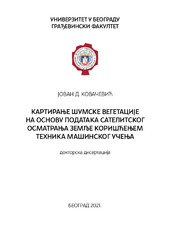Картирање шумске вегетације на основу података сателитског осматрања земље коришћењем техника машинског учења
Mapping forest vegetation from satellite earth observation data using machine learning techniques
| dc.contributor.advisor | Cvijetinović, Željko | |
| dc.contributor.other | Mihajlović, Dragan | |
| dc.contributor.other | Brajović, Ljiljana | |
| dc.contributor.other | Samardžić, Mileva | |
| dc.contributor.other | Lakušić, Dmitar | |
| dc.creator | Kovačević, Jovan | |
| dc.date.accessioned | 2023-12-13T11:44:43Z | |
| dc.date.available | 2023-12-13T11:44:43Z | |
| dc.date.issued | 2022-02-11 | |
| dc.identifier.uri | https://eteze.bg.ac.rs/application/showtheses?thesesId=9414 | |
| dc.identifier.uri | https://fedorabg.bg.ac.rs/fedora/get/o:31985/bdef:Content/download | |
| dc.identifier.uri | https://plus.cobiss.net/cobiss/sr/sr/bib/62990857 | |
| dc.identifier.uri | https://nardus.mpn.gov.rs/handle/123456789/21969 | |
| dc.description.abstract | Потребе за квалитетним подацима квантитативних и квалитативних карактеристика шума се повећавају како је притисак на овај природни ресурс све већи. Подаци сателитског осматрања Земље су се показали као погодна алтернатива теренским методама за прикупљање информација о шумама. Основни циљеви истраживања у оквиру ове дисертације су анализа, развој и унапређење методологије за картирање типова шумске вегетације на основу података сателитског осматрања Земље. Предложена методологија се у основи ослања на издвајање тематских информација из сателитских снимака применом надзираних непараметарских метода класификације, посебно техника машинског учења. Истраживање обухвата утврђивање применљивости различитих техника машинског учења (стабла одлучивања, случајне шуме и градијентног појачавања) за картирање типова шумске вегетације, анализу различитих репрезентација података ради наглашавања просторних и временских аспеката у класификационом моделу, као и примену техника за креирање оптималног балансираног скупа података и избора атрибута од значаја за квалитетно картирање шумске вегетације. Развој и тестирање предложене методологије је извршено идентификацијом осам типова шумске вегетације на подручју Републике Србије. Коришћени су подаци сателитске мисије Sentinel-2 из 2019. године у комбинацији са додатним изворима података. Резултати спроведених експеримената се подударају са резултатима сличних истраживања заснованих на оптичким сателитским опажањима високе просторне резолуције. На основу спроведених експеримената је закључено да је предложена методологија применљива за картирање типова шумске вегетације у Србији. Иако је тестирање извршено на територији Србије, методологија има значајан потенцијал да се примени и на другим подручјима уз прилагођавање класификационе шеме и допуне података за тренирање модела. Такође, може се сматрати да је предложена методологија општег типа, тј. она може бити релативно једноставно прилагођена и другим класификационим проблемима. Додатна истраживања су предвиђена у будућности како би се испитале претходне претпоставке. | sr |
| dc.description.abstract | The necessity for quality data on quantitative and qualitative characteristics of forests is increasing as the pressure on this natural resource rises. Satellite Earth observation data has proven to be a suitable alternative to field methods when it comes to collecting information about forests. The main goals of the research within this dissertation are the analysis, development and improvement of the methodology for mapping forest vegetation types using satellite Earth observation data. The proposed methodology relies on the extraction of thematic information from satellite imagery using supervised non-parametric classification methods, especially machine learning techniques. The research includes determining the applicability of different machine learning techniques (decision tree, random forest and gradient boosting) for mapping forest vegetation types, analysis of different data representations for emphasizing spatial and temporal aspects in the classification model, and applying techniques to create optimal balanced datasets and to determine optimal features for quality mapping of forest vegetation. The development and testing of the proposed methodology were performed by identifying eight forest vegetation types in the Republic of Serbia. Sentinel-2 satellite imagery from the 2019 was used in combination with additional data sources. The results of the conducted experiments match the results of similar studies which were based on high- resolution optical satellite imagery. In accordance with the conducted experiments, it can be concluded that the proposed methodology is applicable for mapping forest vegetation types in Serbia. While the testing was performed on the territory of Serbia, the methodology has significant potential to be applied in other regions as well, with the adjustment of the classification scheme and the additional data for model training. Also, the proposed methodology can be considered to be of a generic type, since it can be relatively easily adapted to other classification problems. Additional research is planned in the future to test these assumptions | en |
| dc.format | application/pdf | |
| dc.language | sr | |
| dc.publisher | Универзитет у Београду, Грађевински факултет | sr |
| dc.rights | openAccess | en |
| dc.rights.uri | https://creativecommons.org/licenses/by-nc-nd/4.0/ | |
| dc.source | Универзитет у Београду | sr |
| dc.title | Картирање шумске вегетације на основу података сателитског осматрања земље коришћењем техника машинског учења | sr |
| dc.title.alternative | Mapping forest vegetation from satellite earth observation data using machine learning techniques | en |
| dc.type | doctoralThesis | |
| dc.rights.license | BY-NC-ND | |
| dc.identifier.fulltext | http://nardus.mpn.gov.rs/bitstream/id/157770/Disertacija_14524.pdf | |
| dc.identifier.fulltext | http://nardus.mpn.gov.rs/bitstream/id/157771/Referat.pdf | |
| dc.identifier.rcub | https://hdl.handle.net/21.15107/rcub_nardus_21969 |



